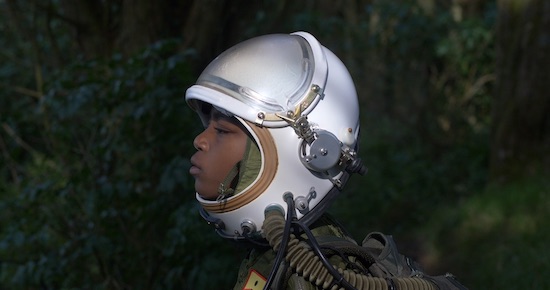Larry Achiampong, Dividednation
As I write this, striking janitors in Miami are marching in protest against low wages with bananas gaffa-taped to their shirts. A work presented at the city’s annual art fair by Maurizio Cattelan – entitled ‘Comedian’, consisting of nothing more than a curved yellow fruit stuck to the wall, and priced at $120,000 – has already sparked a performance by sculptor David Datuna, a global conversation about meaning and value in the art world, and now a mass protest of dispossessed manual workers. Not bad for a 30¢ banana.
So it feels like a strange time to be ranking artists’ work. When even the Turner Prize winners are opting to share, who am I to judge what was ‘the best’ or ‘most important’ work of the year? The following, then, in no particular order, are some shows that tQ’s art writers saw, and liked, and remembered, and found, generally, quite delicious.
Participating in this year’s jury was Allan Gardner, Cathy Wade, John Quinn, Fisun Güner, Andrew Bulhak, Amah-Rose Abrams, and Robert Barry (nb. descriptions attached to specific shows below do not necessarily reflect who voted for that particular exhibition).
Tomás Saraceno – On Air at Palais de Tokyo, Paris
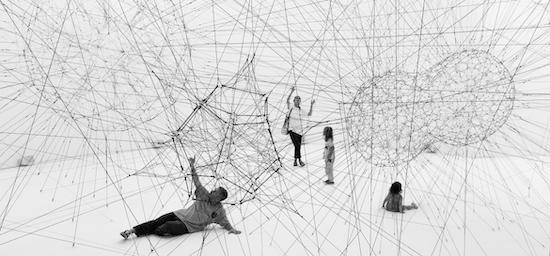
I finally caught Saraceno’s carte blanche exhibition at the Palais de Tokyo late in its run, while visiting family in France at the very beginning of the year. Stepping into its fragile, shimmering world, I was immediately captivated. On Air gave us mutant spiderwebs as musical instruments, the slightest of air currents as active agents in the creation of new works. As the artist writes in his ‘Aerocene Manifesto’, here was art for “a new epoch, free from borders, free from fossil fuels.” Robert Barry
On Air by Tomás Saraceno was at the Palais de Tokyo, Paris, from 17 October 2018 until 6 January 2019
Cady Noland at MMK, Frankfurt
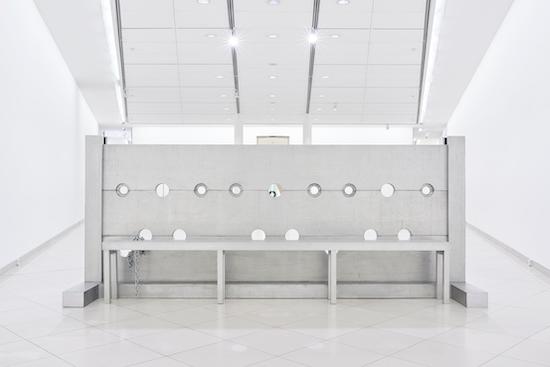
An insistent message thumps as incessantly as a pile driver: America is sick. Noland exposes her country’s psychopathology with a laconic repositioning of its symbolic objects. She has a seer’s vision – that rarest of gifts bestowed on an artist. As potent as the Weimar works of George Grosz she warns and points ahead to the oppressive conditions of our future by giving us a fearful blast of Un-American broadcasting. John Quin
Cady Noland was at MMK, Frankfurt, from 27 October 2018 to 26 May 2019. Read the full review by John Quin
Dorothea Tanning at Tate Modern, London
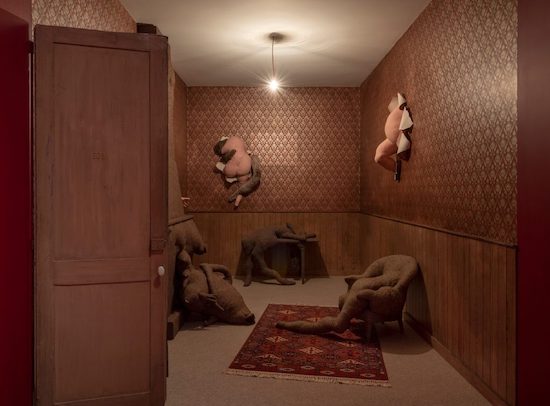
The American surrealist Dorothea Tanning was extraordinarily inventive, not just as a painter of the fantastical and uncanny that was wholly rooted in ‘the female experience’, but she was innovative as a sculptor too, and here she is certainly underrated. Her stuffed fabric forms are genuinely disquieting, capturing the tension between the menacing and the erotic, and between a sense of ‘feminine pliancy’ and imminent threat and danger – she certainly speaks to anxieties around the castration complex. One thinks of Louise Bourgeois and wonder who influenced who. Her creepy and erotically charged life-sized Installation Chambre 202, Hotel du Pavot (1970-3), was a highlight of the exhibition. Fisun Güner
Dorothea Tanning was at Tate Modern from 27 February to 9 June
Don McCullin at Tate Britain, London
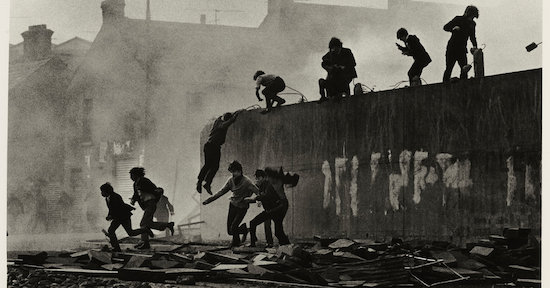
There’s no other way of putting it, McCullin is a genius with the camera and this was possibly – undoubtedly, even – the most powerful survey of any single photographer I’ve seen. But clearly, as a photojournalist and as an eyewitness to the ravages of the late 20th century, it’s hardly technical brilliance that makes him so (and McCullin never received any technical training as a photographer). In every frame he shoots, there is a sense of deep empathy and this hits you hard. If you have an ounce of it yourself, you’ll have come away profoundly affected and changed. Fisun Güner
Don McCullin was at Tate Britain from 5 February to 6 May
Liquid Crystal Display at Middlesbrough Institute of Modern Art
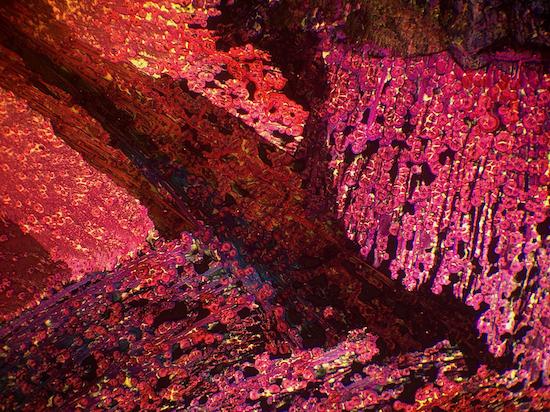
The hidden life and dynamics of liquid crystals informed this exhibition co-curated by MIMA’s Director Laura Sillars and Angelica Sule from Site Gallery. Revised for Middlesbrough Institute of Modern Art from Site Gallery, Liquid Crystal Display was a multi-faceted structure articulating the intersections of scientific breakthroughs and mineral ecologies embedded within the legacies of artists practices. Such a constellation of practices and approaches demanded a context that is flexible and generous. Crystal Fabric Field, a sculptural display device by Anna Barham, manifested an ecology that held together the works in the exhibition. Cathy Wade
Liquid Crystal Display was at Middlesbrough Institute of Modern Art from 23 February to 16 June. Read the full review by Cathy Wade
My Head Is A Haunted House at Sadie Coles HQ and Dracula’s Wedding at Rodeo, London
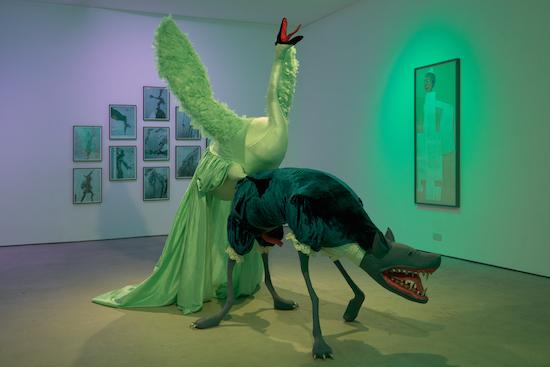
This is a consistent theme between both MHIAHH and Dracula’s Wedding. In each exhibition, every work makes you want to run towards another one. You’re always getting into eyeshot of something to be excited by, something to investigate or something to gawk at.
They’re easy shows to get lost in, reflecting the idea of a haunted house at Halloween. Rather than being guided through the exhibition by curation, the viewer is encouraged to run around – to follow their intuition and to go towards what pulls them. I ended up spending a significant amount of time because of this. You’re never quite certain you’ve seen everything and that’s something that works absolutely in their favour. Allan Gardner
My Head Is A Haunted House was at Sadie Coles HQ from 5 June to 31 August. Dracula’s Wedding was at Rodeo from 4 June to 3 August 2019. Read the full review by Allan Gardner
How Chicago! Imagists 1960s & 70s at De La Warr Pavilion, Bexhill-on-Sea & Goldsmiths CCA, London
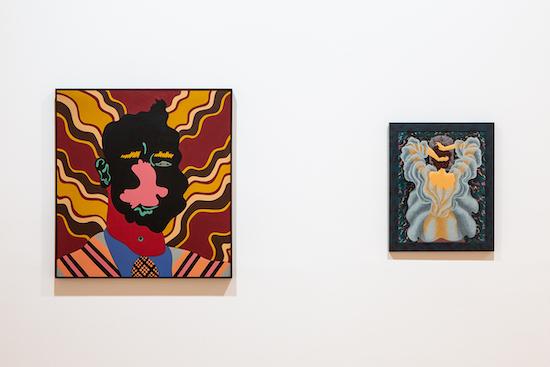
The paintings and constructions of the Imagists often shared elements of both Pop Art and Surrealism. The group had catholic taste, often indifferent to distinctions between high and low culture. They dug comics, the intricate detail of the Dutch Masters, craft and polish, the seemingly naïf work of Outsider Artists and indigenous peoples. And they were deeply into the body and sex and dreams. Surprisingly not many took drugs and not many were into theory. In significant contrast to the then prevalent mood of detachment and cool irony (as typified by Warholian East Coast Pop) it can be observed that the Imagists were disturbingly sincere, and much more hotly engaged. John Quin
How Chicago! Imagists 1960s & 70s was at Goldsmiths CCA from 15 March to 27 May 2019 and at the De La Warr Pavilion from 15 June to 8 September. Read the full review by John Quinn
Larry Achiampong – Dividednation at Primary, Nottingham
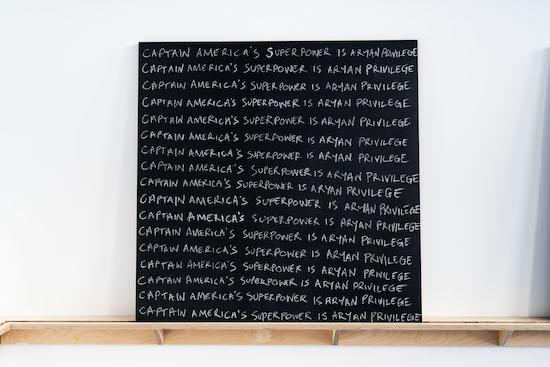
In what is arguably the artist’s most comprehensive presentation to do date, Larry Achiampong’s Dividednation takes place across both gallery spaces in Nottingham’s Primary. Split across two floors and traversing audiovisual, sculpture, installation and text-based works, this exhibition provides an excellent introduction to the myriad forms and dialogues present in Achiampong’s work.
I’ve struggled to write about this exhibition. I enjoyed seeing it, the works included are valuable, interesting pieces which encourage dialogue and are filled with a sense of hope. An anger that motivates change and a desire to force accountability onto oppressors, to fight for a better future. The exhibition is, by any definition, a good one. Allan Gardner
Larry Achiampong – Dividednation was at Primary, Nottingham, from 26 April to 22 June. Read the full review by Allan Gardner
Alex Frost – On-the-Go at Recent Activity, Birmingham
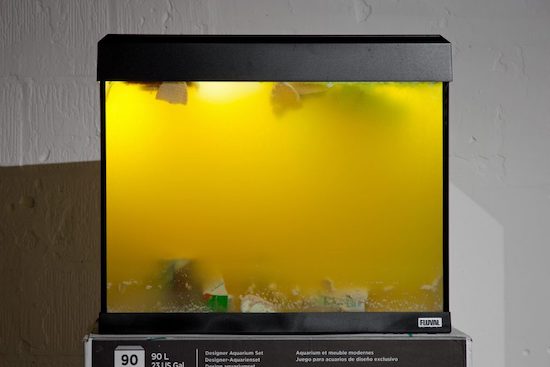
The first exhibition of Frost’s Wet Unboxing videos; On-the-Go screened a selection of video works with a tank in which the plasticised foodstuffs and health supplements of the videos gradually decomposed into dank rancid matter. Shifting and changing through the duration of the show as an uneasy guest in the gallery, variations occurred as fats coagulated and consumable materials broke down into their indigestible parts. Stacked on a pile of cardboard boxes designed to transit office printers, Amazon purchases and the fish tank itself, this wet matter illuminated by inbuilt LED’s was an entropic counterpart to the language of the video work. Cathy Wade
Alex Frost – On-the-Go was at Recent Activity from 8 June to 7 July
Mike Nelson – The Asset Strippers at Tate Britain, London
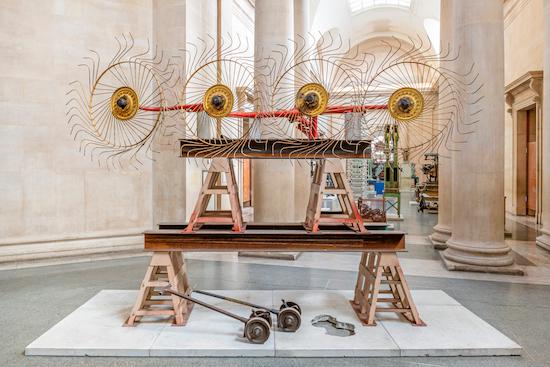
There is a shadow of the dignity of labour in these mute, inutile beasts from yesterday. Now, sadly, we appear to be led by a regime embodying the old cliché that proclaims a poor workman blames his tools. They suggest we blame Parliament or the People, that we blame anyone and anything but the Government itself for our current mess. Back in the day Joseph Duveen ripped off ‘declining European aristocrats’; he clearly functioned as something of a rogue trader. Similarly the last remaining assets of the UK – our NHS for example – may be sold off to the likes of the predatory Trump administration with its well-known antipathy to ‘socialised’ medicine.
The Asset Strippers is Nelson’s urgent warning: look at this and imagine what can happen to the remnants of our welfare state. Don’t bet against our MRI scanners being installed at the Duveen in due course. John Quin
The Asset Strippers by Mike Nelson was at Tate Britain from 18 March to 6 October. Read the full review by John Quin
Berthe Morisot at Musée d’Orsay, Paris
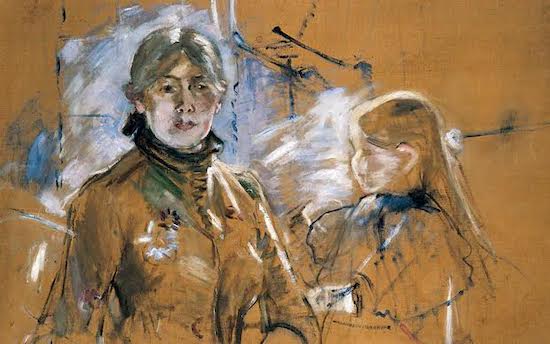
The American painter and printmaker Mary Cassatt and the French painter Berthe Morisot should be familiar names in the Impressionist pantheon. But when was the last time you saw a solo survey of either artist? Certainly not in the UK. So the Morisot exhibition at the Musée d’Orsay came as something of a revelation. The sister-in-law, and muse, of Édouard Manet, Morisot was at the heart of the movement as an artist first and foremost, and her ‘unfinished’ technique, lively brushwork and rapid execution embodied the ‘fleeting impression’ and in many ways foregrounded the intimate paintings of artists such as Toulouse-Lautrec. Fisun Güner
Berthe Morisot was at the Musée d’Orsay, Paris, from 18 June to 22 September
Garden of Earthly Delights at Gropius Bau, Berlin
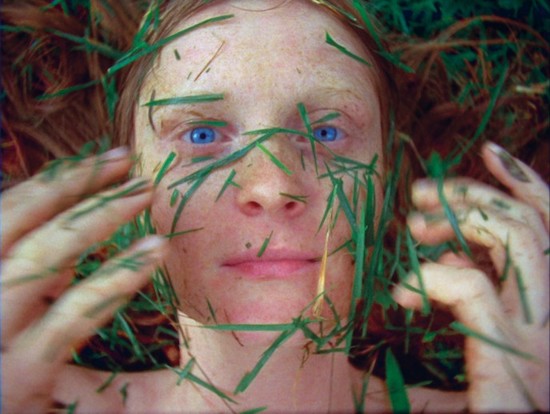
An exhibition riffing off the eponymous Hieronymus Bosch triptych. from meditations on nature to manifestos for better futures, was by necessity a mixed bag. Taro Shinoda reproduces the rocks of a zen garden as flat outlines in marble, while John Cage’s Where R=Ryoanji transforms one into drawings and rhythm patterns. Pipilotti Rist creates a hypersaturated, ceiling-projected Eden in which naked people cavort with fruit to a hypnotic post-rock score, while Zheng Bo imagines people getting frisky with plants, and invites the audience to sketch provided ferns. Libby Harward presents plants, under glass, from colonised areas, inquiring in indigenous languages about where they are, Heather Phillipson imagines a skunk cabbage serenading humanity as it returns to the nitrogen cycle. There is a white room with polka-dotted stylised flowers from Yayoi Kusama, and a neon-coloured pop-art shrine from Korakrit Arunanondchai. At the entrance stands the centrepiece of the Bosch, which, five hundred years on, looks strikingly modern. Andrew Bulhak
Garden of Earthly Delights was at Gropius Bau, Berlin, from 26 July to 1 December
Roy DeCarava – The Sound I Saw / Light Break at David Zwirner, New York
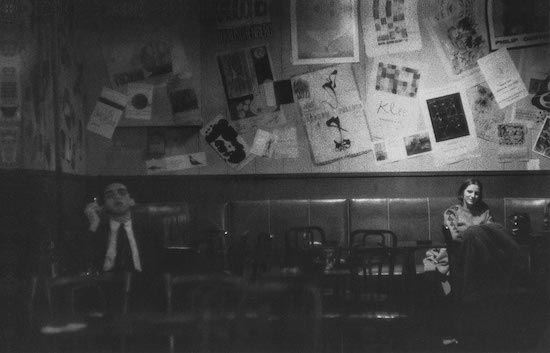
There is a romantic view of New York that I think we all hold in our imaginations, a celebrity city it has an identity that surpasses its everyday reality. DeCarava’s silver gelatin prints in which he deliberately blurs black and white to explore tones of grey have a palpable emotional quality to them.
These images of 1940s New York capture the city in all its iconography with a rare seen emotional charge. His landscapes, cityscapes and portraits are all touched with this quality but it is his images of jazz musicians including John Coltrane and Billie Holiday are truly touched with genius. These still moments in the heat of performance see players dripping in sweat, lost in the moment, at one with the audience or lost in their art. Through an expression or simply a hand gesture you can almost hear the music. I didn’t know DeCarava’s work before seeing these works but I am now forever a fan. Amah-Rose Abrams
Roy DeCarava – The Sound I Saw & Light Break were at David Zwirner, New York, from 5 September to 26 October
Alberta Whittle – How Flexible Can We Make The Mouth at Dundee Contemporary Arts
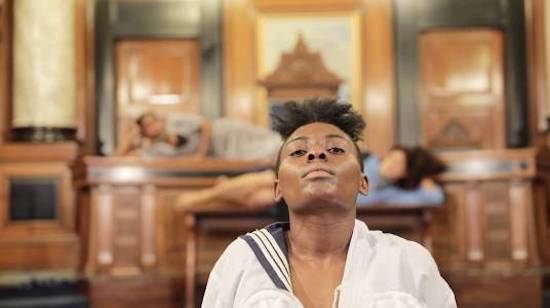
I hadn’t heard of Alberta Whittle before I saw this show and when I discovered later that she has mainly focused on performance ahead of this show it made a bit more sense but her lack of fame is still puzzling.
A combination of film, installation, prints and performance addressing black and queer identity through the lens of climate change this show stood out to me as it addressed popular themes in a fresh way. Starting from the point of how climate change affects areas of the Caribbean (Whittle was born in Barbados and grew in Scotland) in relation to poverty and combining that with themes of black Scottish queer identity this show brought together complex themes into a coherent, stunningly well-realised exhibition.
Visiting DCA also highlighted to me how we need to better connect the art world and media in London to the scenes across the UK as well as it is connected to the international art world, Whittle is a star and we should know her better! Amah-Rose Abrams
Alberta Whittle – How Flexible Can We Make The Mouth at Dundee Contemporary Arts from 14 September to 24 November
Keith Piper – Body Politics, work from 1982–2007 at Wolverhampton Art Gallery
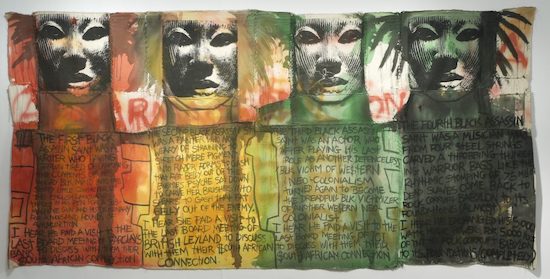
Pipers solo show at Wolverhampton was a return to the gallery in which he exhibited in the show Black Art an’ Done in 1981 as a member of Wolverhampton Young Black Artists (later the Blk Art Group). The exhibition revealed how uncannily close we are to the temperature and apocalyptic rhetoric of Thatcherism. Works included The Four Horsemen of the Apocalypse and Black Assassin Saints which felt embedded in the present and a reminder of the critical need for dissent to be articulated. Trophies of Empire transferred from photographic slide to video looped through structural histories of abuse against the black body, alongside pioneering digital works made in the 1990s. Cathy Wade
Keith Piper – Body Politics, work from 1982 – 2007 was at Wolverhampton Art Gallery from 10 October to 1 December
Nam June Paik at Tate Modern, London
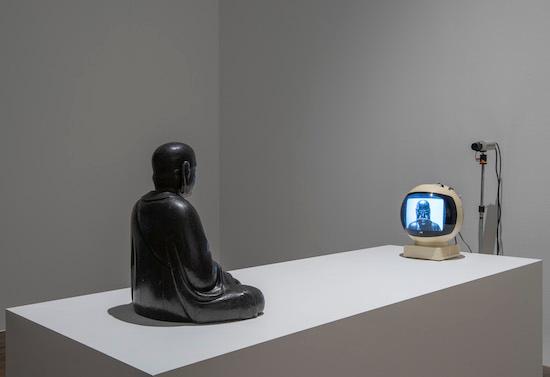
Nam June Paik, is, like me, seriously in love with the technology of the cathode ray tube. Its impossibilities. He is drawn to it, like the people of his generation, like a moth to a candle. He is sucked in by his eyes into its materiality. It is a different sensation to the cold LED light, the chill of the plasma screens, their sheeny flatness. There is a warmth, a softness, an electric hum at the heart of the cathode ray box. It is his appreciation of this that draws me in. Even though I am not a Buddhist, and this informs everything that Paik does, I appreciate the visceral symbolism. The lit candle inside the TV case is universally resonant. This was the domestic shrine of my generation. Jude Cowan Montague
Nam June Paik is (still) at Tate Modern until 9 February 2020

